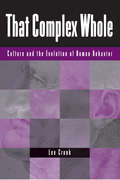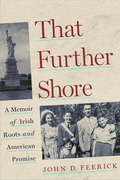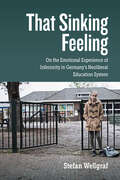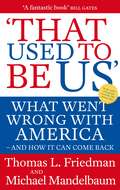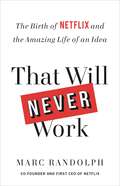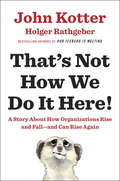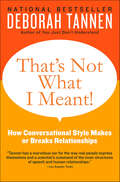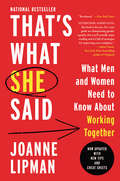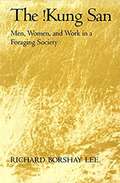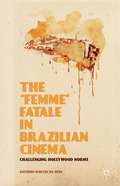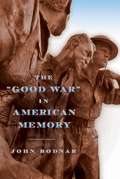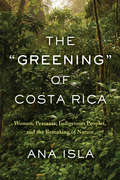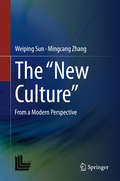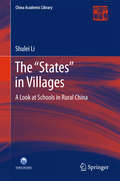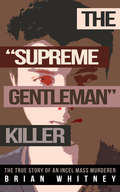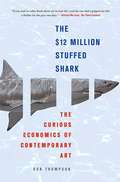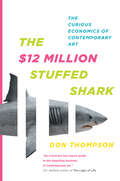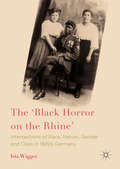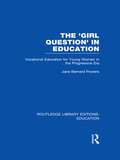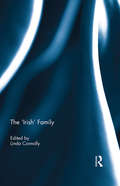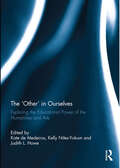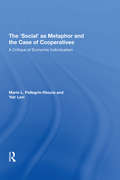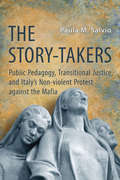- Table View
- List View
That Complex Whole: Culture And The Evolution Of Human Behavior
by Lee CronkOur understanding of the evolution of human behavior has grown enormously over the past few decades, and an increasing number of behavioral and social scientists are making use of evolutionary theory in their work to shed light on issues ranging from marriage and parenting to the study of mental illness. The success of this research program is thre
That Further Shore: A Memoir of Irish Roots and American Promise
by John D. FeerickA rare and evocative memoir of a respected constitutional scholar, dedicated public servant, political reformer, and facilitator of peace in the land of his ancestors.John D. Feerick’s life has all the elements of a modern Horatio Alger story: the poor boy who achieves success by dint of his hard work. But Feerick brought other elements to that classic American success story: his deep religious faith, his integrity, and his paramount concern for social justice. In his memoir, The Further Shore, Feerick shares his inspiring story, from his humble beginnings: born to immigrant parents in the South Bronx, going on to practice law, participating in framing the U.S. Constitution’s Twenty-Fifth Amendment, serving as dean of Fordham Law, and serving as President of the New York City Bar Association and chair of state commissions on government integrity.Beginning with Feerick’s ancestry and early life experiences, including a detailed genealogical description of Feerick’s Irish ancestors in County Mayo and his laborious quest to identify them and their relationships with one another, the book then presents an evocative survey of the now-vanished world of a working-class Irish Catholic neighborhood in the South Bronx. Feerick’s account of how he financed his education from elementary school through law school is a moving tribute to the immigrant work ethic that he inherited from his parents and shared with many young Americans of his generation. The book then traces Feerick’s career as a lawyer and how he gave up a lucrative partnership in a prestigious New York City law firm at an early age to accept the office of Dean of the Fordham School of Law at a fraction of his previous income because he felt it was time to give back something to the world.John Feerick has consistently shown his commitment to the law as a vocation as well as a profession by his efforts to protect the rights of the poor, to enable minorities to achieve their rightful places in American society, and to combat political corruption. That Further Shore is an inspiring memoir of how one humble and decent man helped to make America a more just and equitable society.
That Futebol Feeling: Sport and Play in Brazil's Heartland
by David FaflikFutebol, or soccer for Americans, is the planet’s spectator sport of choice. In the Brazilian state of Minas Gerais, nestled in the country’s southeastern heartland, futebol generates powerful, lifelong emotions. That Futebol Feeling captures the region’s enthrallment with “the beautiful game,” and shows us how and why play is central to the human condition. David Faflik profiles members of the most celebrated local team, Clube Atlético Mineiro (CAM), as well as its passionate, never-say-die fans, to show how futebol and fandom shape their everyday lives and perspectives. He discovers bonds of work and play, as well as pride, identity, and community. Additionally, Faflik’s analysis of Brazil’s futebol culture reflects sports fandom worldwide. CAM stands as a symbol for a way of life in Minas Gerais, the birthplace of Pelé. Faflik interrogates what playing the game means to those who dedicate their lives to the sport. He writes, “The feelings that football inspires are the best of me.” That Futebol Feeling shares that special feeling with the rest of us.
That Sinking Feeling: On the Emotional Experience of Inferiority in Germany's Neoliberal Education System
by Stefan WellgrafEmotions, especially those of impoverished migrant families, have long been underrepresented in German social and cultural studies. That Sinking Feeling raises the visibility of the emotional dimensions of exclusion processes and locates students in current social transformations. Drawing from a year of ethnographic fieldwork with grade ten students, Stefan Wellgraf’s study on an array of both classic emotions and affectively charged phenomena reveals a culture of devaluation and self-assertion of the youthful, post-migrant urban underclass in neoliberal times.
That Used To Be Us: What Went Wrong with America - and How It Can Come Back
by Michael Mandelbaum Thomas FriedmanAmerica has a huge problem. It faces four major challenges, on which its future depends, and it is failing to meet them. In What's Wrong with America?, Thomas L. Friedman and Michael Mandelbaum analyze those challenges - globalization, the revolution in information technology, the nation's chronic deficits, and its pattern of energy consumption - and spell out what needs to be done now to rediscover America's power and prowess.They explain how the end of the cold war blinded the nation to the need to address these issues seriously. They show how America's history, when properly understood, provides the key to coping successfully and explain how the paralysis of the US political system and the erosion of key American values have made it impossible to carry out the policies the country needs. What's Wrong with America? is both a searching exploration of the American condition today and a rousing manifesto for American renewal.
That Will Never Work: The Birth of Netflix and the Amazing Life of an Idea
by Marc RandolphIn the tradition of Phil Knight's Shoe Dog comes the incredible untold story of how Netflix went from concept to company-all revealed by co-founder and first CEO Marc Randolph. Once upon a time, brick-and-mortar video stores were king. Late fees were ubiquitous, video-streaming unheard was of, and widespread DVD adoption seemed about as imminent as flying cars. Indeed, these were the widely accepted laws of the land in 1997, when Marc Randolph had an idea. It was a simple thought-leveraging the internet to rent movies-and was just one of many more and far worse proposals, like personalized baseball bats and a shampoo delivery service, that Randolph would pitch to his business partner, Reed Hastings, on their commute to work each morning. But Hastings was intrigued, and the pair-with Hastings as the primary investor and Randolph as the CEO-founded a company. Now with over 150 million subscribers, Netflix's triumph feels inevitable, but the twenty first century's most disruptive start up began with few believers and calamity at every turn. From having to pitch his own mother on being an early investor, to the motel conference room that served as a first office, to server crashes on launch day, to the now-infamous meeting when Netflix brass pitched Blockbuster to acquire them, Marc Randolph's transformational journey exemplifies how anyone with grit, gut instincts and determination can change the world-even with an idea that many think will never work. What emerges,though, isn't just the inside story of one of the world's most iconic companies. Full of counter-intuitive concepts and written in binge-worthy prose, it answers some of our most fundamental questions about taking that leap of faith in business or in life: How do you begin? How do you weather disappointment and failure? How do you deal with success? What even is success? From idea generation to team building to knowing when it's time to let go, That Will Never Work is not only the ultimate follow-your-dreams parable, but also one of the most dramatic and insightful entrepreneurial stories of our time.
That's Not How We Do It Here!: A Story about How Organizations Rise and Fall--and Can Rise Again
by John Kotter Holger RathgeberWhat's the worst thing you can hear when you have a good idea at work?"That's not how we do it here!" In their iconic bestseller Our Iceberg Is Melting, John Kotter and Holger Rathgeber used a simple fable about penguins to explain the process of leading people through major changes. Now, ten years later, they're back with another must-read story that will help any team or organization cope with their biggest challenges and turn them into exciting opportunities. Once upon a time a clan of meerkats lived in the Kalahari, a region in southern Africa. After years of steady growth, a drought has sharply reduced the clan's resources, and deadly vulture attacks have increased. As things keep getting worse, the harmony of the clan is shattered. The executive team quarrels about possible solutions, and suggestions from frontline workers face a soul-crushing response: "That's not how we do it here!" So Nadia, a bright and adventurous meerkat, hits the road in search of new ideas to help her troubled clan. She discovers a much smaller group that operates very differently, with much more teamwork and agility. These meerkats have developed innovative solutions to find food and evade the vultures. But not everything in this small clan is as perfect as it seems at first. Can Nadia figure out how to combine the best of both worlds--a large, disciplined, well-managed clan and a small, informal, inspiring clan--before it's too late? This book distills Kotter's decades of experience and award-winning research to reveal why organizations rise and fall, and how they can rise again in the face of adversity.From the Hardcover edition.
That's Not What I Meant!: How Conversational Style Makes or Breaks Relationships
by Deborah TannenThe bestselling linguistics professor examines how we communicate with each other and how you can maintain an effective conversation.At home, on the job, in a personal relationship, it’s often not what you say but how you say it that counts.Deborah Tannen revolutionized our thinking about relationships between women and men in her #1 bestseller You Just Don’t Understand. In That’s Not What I Meant!, the internationally renowned sociolinguist and expert on communication demonstrates how our conversational signals—voice level, pitch and intonation, rhythm and timing, even the simple turns of phrase we choose—are powerful factors in the success or failure of any relationship. Regional speech characteristics, ethnic and class backgrounds, age, and individual personality all contribute to diverse conversational styles that can lead to frustration and misplaced blame if ignored—but provide tools to improve relationships if they are understood.At once eye-opening, astute, and vastly entertaining, Tannen’s classic work on interpersonal communication will help you to hear what isn’t said and to recognize how your personal conversational style meshes or clashes with others. It will give you a new understanding of communication that will enable you to make the adjustments that can save a conversation . . . or a relationship.“Tannen combines a novelist’s ear for the way people speak with a rare power of original analysis. . . . Fascinating.” —Oliver Sacks“We are, all of us, foreigners to each other: editor and writer, man and woman, Californian and New Yorker, friend and friend. Dr. Tannen shows us how different we are, and how to speak the same language.” —Jack Rosenthal, Pulitzer Prize winner and editor, The New York Times“Tannen has a marvelous ear for the way real people express themselves and a scientist’s command of the inner structures of speech and human relationships.” —Los Angeles Times
That's What She Said (and Women Need to Tell Them) About Working Together: What Men Need to Know (and Women Need to Tell Them) About Working Together
by Joanne LipmanGoing beyond the message of Lean In and The Confidence Code, Gannett’s Chief Content Officer contends that to achieve parity in the office, women don’t have to change—men do—and in this inclusive and realistic handbook, offers solutions to help professionals solve gender gap issues and achieve parity at work.Companies with more women in senior leadership perform better by virtually every financial measure, and women employees help boost creativity and can temper risky behavior—such as the financial gambles behind the 2008 economic collapse. Yet in the United States, ninety-five percent of Fortune 500 chief executives are men, and women hold only seventeen percent of seats on corporate boards. More men are reaching across the gender divide, genuinely trying to reinvent the culture and transform the way we work together. Despite these good intentions, fumbles, missteps, frustration, and misunderstanding continue to inflict real and lasting damage on women’s careers.What can the Enron scandal teach us about the way men and women communicate professionally? How does brain circuitry help explain men’s fear of women’s emotions at work? Why did Kimberly Clark blindly have an all-male team of executives in charge of their Kotex tampon line? In That’s What She Said, veteran media executive Joanne Lipman raises these intriguing questions and more to find workable solutions that individual managers, organizations, and policy makers can employ to make work more equitable and rewarding for all professionals.Filled with illuminating anecdotes, data from the most recent relevant studies, and stories from Lipman’s own journey to the top of a male-dominated industry, That’s What She Said is a book about success that persuasively shows why empowering women as true equals is an essential goal for us all—and offers a roadmap for getting there.
The !kung San: Men, Women, And Work In A Foraging Society
by Richard B. LeeFor most of human history hunting and gathering was a universal way of life. Richard Borshay Lee spent over three years conducting fieldwork among the !Kung San, an isolated population of 1,000 in northern Botswana. When Lee began his work in 19863, the !Kung San were one of the last of the world's people to live this life. By 1973, when Lee last lived with the group, it appeared that they !Kung were a society on the threshold of a transformation that signalled the end of foraging as an independent way of life, at least in Africa. The !Kung San: Men, Women and Work in a Foraging Society, an ecological and historical study, is Professor Lee's major statement on his research. By maintaining simultaneous historical and synchronic perspectives, Lee is able to extend his analysis of core features from the contemporary !Kung to prehistoric societies. These basic principles become the means to understanding the form of human life that has been obscured by the developments and complications of societies during the last few thousand years.
The "Femme" Fatale in Brazilian Cinema: Challenging Hollywood Norms
by Antônio Márcio da SilvaIn film, the femme fatale has long been constructed as a beautiful heterosexual Caucasian woman. Da Silva shows the need to incorporate diverse ethnic groups and male homosexuals into the range of "femmes" fatales and examines how the Brazilian representations cross gender, race, and class and offer alternatives to the dominant Hollywood model.
The "Good War" in American Memory
by John BodnarThe "Good War" in American Memory dispels the long-held myth that Americans forged an agreement on why they had to fight in World War II. Looking back after more than half a century there seems little dispute that World War II was a 'good war', but at the time and for many decades after U.S. society was driven by an intense debate over why it had been necessary to enter such a conflict. This study explores the arguments.
The "Greening" of Costa Rica: Women, Peasants, Indigenous Peoples, and the Remaking of Nature
by Ana IslaSince the 1992 Earth Summit in Rio de Janeiro, the concept of sustainable development has become the basis for a vast number of "green industries" from eco-tourism to carbon sequestration. <P><P>In The "Greening" of Costa Rica, Ana Isla exposes the results of the economist's rejection of physical limits to growth, the biologist's fetish with such limits, and the indebtedness of peripheral countries. <P><P>Isla's case study is the 250,000 hectare Arenal-Tilaran Conservation Area, created in the late 1990s as the result of Canada-Costa Rica debt-for-nature swaps. <P><P> Rather than reducing poverty and creating equality, development in and around the conservation area has dispossessed and disenfranchised subsistence farmers, expropriating their land, water, knowledge, and labour. <P><P>Drawing on a decade of fieldwork in these communities, Isla exposes the duplicity of a neoliberal model in which the environment is converted into commercial assets such as carbon credits, intellectual property, cash crops, open-pit mining, and eco-tourism, few of whose benefits flow to the local population.
The "New Culture"
by Weiping Sun Mingcang ZhangContemporary China, in an era of globalization and in the midst of transition, now faces both great opportunities and unprecedented challenges. People are more and more becoming "economic man," "technological man" and "one-dimensional man," and are increasingly losing the virtue, dignity and beauty of human nature. When humanity's habitat grows smaller and smaller as economic, technological, informational and social interaction become more and more intense, while conflicts of interest and clashing values are growing increasingly heated, how should different religions, national groups and states deal with each other? As environmental pollution worsens, our ecosystem becomes increasingly unstable and population growth becomes an unbearable burden, where shall we look for a homeland where we can rest our weary minds? . . . To answer these daunting questions and address their attendant challenges, all human activities, including institutional arrangements, economic constructions, and science and the arts, must all start from the change of humankind, re-think the true nature of humankind and its needs, and consider the prospect of humankind evolving into a "better humankind. " This book is an exploration of such inquires.
The "States" in Villages
by Shulei LiThis book presents a study in educational sociology, exploring the function of rural schools, which are a symbol of the state in rural society, in a time characterized by local cultural transition. The book begins with an investigation of the status quo, background and history of a representative rural school, Fengning Hope Elementary School, and gives a definition of "the 'states' in villages. " Subsequently, on the basis of research on the teachers, an analysis of the courses taught, and comparison to other rural elementary schools of the same type, it reveals the dual status of rural schools and their relation with social development in rural areas. Based on thorough fieldwork and empirical research, the book provides a new vision of the interactive relation between the state and rural society, particularly focusing on the role of rural education in that relation. In addition, it explores the reshaping of Chinese culture and the part that intellectuals play in the process of today's cultural transition. For English-language readers and Western professionals, this translated version will offer an essential window into Chinese studies from a local point of view.
The "Supreme Gentleman" Killer: The True Story of an Incel Mass Murderer
by Brian WhitneyTrue Crime Garage Podcast Recommended Reading. &“The bizarre story of Elliot Rodger . . . prepare to have your mind blown.&”—Patrick Quinlan,bestsellingauthor of Smoked This is the story of Elliot Rodger, and how he turned from a nice, quiet polite young man to the first self-identified incel (involuntarily celibate) killer . . . Elliot Rodger considered himself to be intelligent, refined, handsome, fashionable and charming. He spent years trying to be cool so women would like him. He thought if he just wore expensive and fashionable clothing, had a better car, or if he were rich, then women would throw themselves at him. In fact, he thought himself to be &“The Supreme Gentleman.&” Yet, women paid no attention to him. His only conclusion was that they were genetically flawed, and because of this they ignored him and threw themselves at men who were ignorant, savage brutes. In his mind, his lack of success with women had ruined his life. He began to psychologically deteriorate. Rodger decided to get revenge. He spent months planning his &“Day of Retribution,&” an act where he would kill as many attractive women, and the type of men that they were drawn to, as he could in a savage attack. Then he acted on his plan, killing 6 people and wounding numerous others in what became known as the Isla Vista Massacre. The story does not end with Rodger however, as numerous other incels have since committed copycat attacks.
The #MeToo Reckoning: Facing the Church's Complicity in Sexual Abuse and Misconduct
by Ruth Everhart2020 Publishers Weekly Book of the Year - Religion
The $12 Million Stuffed Shark: The Curious Economics of Contemporary Art
by Don ThompsonWhy would a smart New York investment banker pay $12 million for the decaying, stuffed carcass of a shark? By what alchemy does Jackson Pollock's drip painting No. 5, 1948 sell for $140 million? Intriguing and entertaining, The $12 Million Stuffed Shark is a Freakonomics approach to the economics and psychology of the contemporary art world. Why were record prices achieved at auction for works by 131 contemporary artists in 2006 alone, with astonishing new heights reached in 2007? Don Thompson explores the money, lust, and self-aggrandizement of the art world in an attempt to determine what makes a particular work valuable while others are ignored. This book is the first to look at the economics and the marketing strategies that enable the modern art market to generate such astronomical prices. Drawing on interviews with both past and present executives of auction houses and art dealerships, artists, and the buyers who move the market, Thompson launches the reader on a journey of discovery through the peculiar world of modern art. Surprising, passionate, gossipy, revelatory, The $12 Million Stuffed Shark reveals a great deal that even experienced auction purchasers do not know.
The $12 Million Stuffed Shark: The Curious Economics of Contemporary Art
by Don ThompsonThe $12 Million Stuffed Shark delves into the economics and psychology of the contemporary art world – artists, dealers, auction houses, and wealthy collectors. If it’s true – as so often said – that 85 percent of new contemporary art is bad, why were record prices achieved at auction for works by 131 contemporary artists in 2006 alone, with astonishing new heights reached in 2007? The $12 Million Stuffed Shark explores money, lust, and the self-aggrandizement of possession in an attempt to determine what makes a particular work of art valuable while others are ignored. In the style of the bestselling Freakonomics, Thompson uses economic concepts to explain the unique practices employed, to great success, in the international contemporary art market. He discusses branding and marketing and how various strategies are tailored to a wealthy clientele, driving a "must-have" culture. Drawing on exclusive interviews with both past and present executives of auction houses and art dealerships, artists, and the buyers who move the market, Thompson launches the reader on a surprising journey of discovery.
The 'Black Horror on the Rhine'
by Iris WiggerThis book explores the 'Black Horror' campaign as an important chapter in the popularisation of racialised discourse in European history. Originating in early 1920s Germany, this international racist campaign was promoted through modern media, targeting French occupation troops from colonial Africa on German soil and using stereotypical images of 'racially primitive', sexually depraved black soldiers threatening and raping 'white women' in 1920s Germany to generate widespread public concern about their presence. The campaign became an international phenomenon in Post-WWI Europe, and had followers throughout Europe, the US and Australia. Wigger examines the campaign's combination of race, gender, nation and class as categories of social inclusion and exclusion, which led to the formation of a racist conglomerate of interlinked discriminations. Her book offers readers a rare insight into a widely forgotten chapter of popular racism in Europe, and sets out the benefits of a historically reflexive study of racialised discourse and its intersectionality.
The 'Girl Question' in Education: Vocational Education for Young Women in the Progressive Era (Routledge Library Editions: Education)
by Jane Bernard-PowersThis book is a history of the genesis and development of vocational education for young women in the United States. Home economics, trade training and commercial education – the three key areas of vocational training available to young women during the progressive era – are the focus of this work. Beginning with a study of the "woman question", or what women were supposed to be, the book traces the three curriculum areas from prescription, through lively discussions of policy to the actual programs and student responses to the programs. The author tells the story of education for work from several different perspectives and draws on a vast array of sources to paint this broad canvas of vocational education for young women at the turn of the twentieth century.
The 'Irish' Family
by Linda ConnollyWhen situated in the wider European context, ‘the Irish family’ has undergone a process of profound transformation and rapid change in very recent decades. Recent data cites a significant increase in one parent households and a high non-marital birth rate for instance alongside the emergence of cohabitation, divorce, same sex families and reconstituted families. At the same time, the majority of children in Ireland still live in a two-parent family based on marriage and the divorce rate in Ireland is comparatively lower than other European countries. 21st century family life is, in reality, characterised by continuity and change in the Irish context. This book seeks to understand, interpret and theorise family life in Ireland by providing a detailed analysis of historical change, demographic trends, fertility and reproduction, marriage, separation and divorce, sexualities, children and young people, class, gender, motherhood, intergenerational relations, grandparents, ethnicity, globalisation, technology and family practices. A comprehensive analysis of key developments and trends over the course of the twentieth and twenty-first centuries is provided.
The 'Other' in Ourselves: Exploring the educational power of the humanities and arts
by Kate de Medeiros, Kelly Niles-Yokum and Judith L. HoweIncreasingly, scholars from many disciplines have begun to incorporate various modalities from the humanities and arts – novels, films, artwork, and other forms of expression – to help connect students with the experience of aging in deeply meaningful and person-centered ways. This collection examines how these approaches are incorporated into gerontology and geriatrics education. Rather than focusing solely on measurable outcomes, such as changes in learning over time – which is the purview of empirical pedagogy – chapters focus on strategies for successfully incorporating a specific work into the classroom, descriptions of humanities and/or arts exercises with students or older adults, and other ways that explore how the humanities and arts can be applied successfully and meaningfully in educational settings. This book was originally published as a special issue of Geronotology & Geriatrics Education.
The 'Social' as Metaphor and the Case of Cooperatives: A Critique of Economic Individualism
by Marie L. Pellegrin-ResciaDrawing on Polanyi, Austin and Lacan, Marie Pellegrin-Rescia and Yair Levi offer a powerful critique of the language and categories of thought that dominate the contemporary intellectual and political landscape. The general tendency to dichotomize concepts such as left and right, social and economic, globalization and anti-globalization, is, they argue, a consequence of our subservience to the primacy of the rational economic agent. The authors offer a selection of case-studies of co-operatives, which are shown to be paradoxical entities in a worldview in which the social exists only as a metaphor for a space concerned with the damage caused by the economic. Through an analysis of experiences in achieving civil accord in South Africa and in establishing a new town in the mountains of Sicily, they offer a new political orientation in a world of uncertainty. In doing so they attempt an answer to one of the most intriguing questions of our time: should we accept as a fait-accompli the way our society is conceived and shaped, or can we have a say in the matter and assume the ethical responsibility involved?
The 'Story-Takers': Public Pedagogy, Transitional Justice and Italy's Non-Violent Protest against the Mafia
by Paula SalvioThe Story-Takers charts new territory in public pedagogy through an exploration of the multiple forms of communal protests against the mafia in Sicily. Writing at the rich juncture of cultural, feminist, and psychoanalytic theories, Paula M. Salvio draws on visual and textual representations including shrines to those murdered by the mafia, photographs, and literary and cinematic narratives, to explore how trauma and mourning inspire solidarity and a quest for justice among educators, activists, artists, and journalists living and working in Italy. Salvio reveals how the anti-mafia movement is being brought out from behind the curtains, with educators leading the charge. She critically analyses six cases of communal acts of anti-mafia solidarity and argues that transitional justice requires radical approaches to pedagogy that are best informed by journalists, educators, and activists working to remember, not only victims of trauma, but those who resist trauma and violence.
